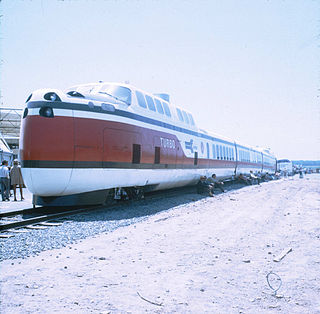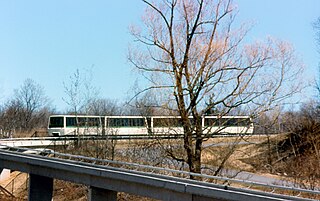Related Research Articles

Personal Rapid Transit (PRT), also referred to as podcars or guided/railed taxis, is a public transport mode featuring small low-capacity automated vehicles operating on a network of specially built guideways. PRT is a type of automated guideway transit (AGT), a class of system which also includes larger vehicles all the way to small subway systems. In terms of routing, it tends towards personal public transport systems.

A people mover or automated people mover (APM) is a type of small scale automated guideway transit system. The term is generally used only to describe systems serving relatively small areas such as airports, downtown districts or theme parks.

An automated guideway transit (AGT) or automated fixed-guideway transit or automatic guideway transit system is a type of fixed guideway transit infrastructure with a riding or suspension track that supports and physically guides one or more driverless vehicles along its length. The vehicles are often rubber tired or steel wheeled, but other traction systems including air cushion, suspended monorail and maglev have been implemented. The guideway provides both physical support, like a road, as well as the guidance.

Guided buses are buses capable of being steered by external means, usually on a dedicated track or roll way that excludes other traffic, permitting the maintenance of schedules even during rush hours. Unlike trolleybuses or rubber-tired trams, for part of their routes guided buses are able to share road space with general traffic along conventional roads, or with conventional buses on standard bus lanes.
Cabinentaxi, sometimes Cabintaxi in English, was a German people mover development project undertaken by Demag and Messerschmitt-Bölkow-Blohm with funding and support from the Bundesministerium für Forschung und Technologie. Cabinentaxi was designed to offer low-cost mass transit services where conventional systems, like a metro, would be too expensive to deploy due to low ridership or high capital costs.

Morgantown Personal Rapid Transit is a personal rapid transit (PRT) system in Morgantown, West Virginia, United States. The system connects the three Morgantown campuses of West Virginia University (WVU) and the city's downtown area.

A dual-mode vehicle (DMV) is a vehicle that can operate on conventional road surfaces as well as a railway track or a dedicated track known as a guideway. The development of these vehicles started together with personal rapid transport systems in the 1950s or even earlier.

The US Standard Light Rail Vehicle (SLRV) was a light rail vehicle (LRV) built by Boeing Vertol in the 1970s. The Urban Mass Transportation Administration (UMTA) of the United States Department of Transportation (USDOT) promoted it as a standardized vehicle for U.S. cities. Part of a series of defense conversion projects in the waning days of the Vietnam War, the SLRV was seen as both a replacement for older PCC streetcars in many cities and as a catalyst for cities to construct new light rail systems. The US SLRV was marketed as and is popularly known as the Boeing LRV or SLRV, and should not be confused with their prior lunar roving vehicles for NASA.

Ultra is a personal rapid transit podcar system developed by the British engineering company Ultra Global PRT.

U.S. International Transportation Exposition, better known as Transpo '72, was a trade show held on 300 acres (1.2 km2) of land at Dulles International Airport outside Washington, D.C., for nine days from May 27 to June 4, 1972. The $10 million event, sponsored by the U.S. Department of Transportation, was a showcase for all sorts of transportation-related technologies. Over a million visitors flocked to the show from all over the world. According to the Wall Street Journal, it was "the biggest show the government has put on since World War II."

LTV's (Vought) Airtrans was an automated people mover system that operated at Dallas/Fort Worth International Airport between 1974 and 2005. The adaptable people mover was utilized for several separate systems: the Airport Train, Employee Train, American Airlines TrAAin and utility service. All systems utilized the same guideways and vehicle base but served different stations to create various routes.
The ACT, acronym for Automatically Controlled Transportation or Activity Center Transit, was a people mover system developed during the 1970s. One feature of the ACT is that it allowed bi-directional travel on a single rail—cars passed each other by switching onto short bypass lanes on the track, distributed where space allowed. ACT was a contender in the Urban Mass Transportation Administration's plan to deploy three or four systems in cities in the United States, as well as the GO-Urban project in Toronto, Canada. One ACT system was installed as a part of a Ford-funded real estate development near their headquarters in Dearborn, MI, and although they proposed to install ACT in several other locations, no additional systems were ever installed and the project was put on indefinite hold.
ROMAG was a personal rapid transit (PRT) system produced by the American company Rohr, Inc. It featured a linear induction motor that was arranged to provide both traction and suspension in a magnetic levitation system.
The HUD Reports were a series of studies in mass transit systems, funded by the Urban Mass Transportation Administration (UMTA) department of the United States Department of Housing and Urban Development (HUD). The HUD reports were extremely influential in the development of the personal rapid transit (PRT) concept, small pod-like vehicles that automatically travel from point-to-point in extended networks. Their publication in early 1968 sparked off PRT development projects at dozens of companies around the world. In spite of intense interest in the early 1970s, political winds shifted and today there is only one HUD-inspired PRT system in commercial operation, the Morgantown PRT in West Virginia.
The Computer-controlled Vehicle System, almost universally referred to as CVS, was a personal rapid transit (PRT) system developed by a Japanese industrial consortium during the 1970s. Like most PRT systems under design at the same time, CVS was based around a small four-person electric vehicle similar to a small minivan that could be requested on demand and drive directly to the user's destination. Unlike other PRT systems, however, CVS also offered cargo vehicles, included "dual-use" designs that could be manually driven off the PRT network, and included the ability to stop at intersections in a conventional road-like network.
Krauss-Maffei's Transurban was a 12-passenger automated guideway transit (AGT) mass transit system based on a maglev guideway. Development started in 1970 as one of the many AGT and PRT projects that followed in the wake of the HUD reports of 1968. Its selection as the basis of the GO-Urban system in Toronto in 1973 made it well known in the industry; it would have been the basis of the first large-area AGT mass transit network in the world. Technical problems cropped up during the construction of the test track, and the sudden removal of funding by the West German government led to the project's cancellation in late 1974. The Ontario government completed development and installation of a non-maglev version, today known as the Bombardier Advanced Rapid Transit.

The Dashaveyor was an automated guideway transit (AGT) system developed during the 1960s and '70s.
Minitram was an automated guideway transit system studied by the Transport and Road Research Laboratory (TRRL), part of the UK Department of the Environment's Ministry of Transport. The system was based on small, completely automated tram-like vehicles of about 25 passengers that could be connected together into three-car trains to increase capacity. Proposed designs were submitted by Hawker Siddeley Dynamics (HSD) and EASAMS. HSD's system used rubber wheels and EASAMS' steerable steel ones, but the projects were otherwise similar and notably shared a linear motor for propulsion and most braking. A series of failed sales efforts in the UK and to the GO-Urban system in Toronto, combined with decreased government spending in the 1970s, led to the concept being abandoned.
In the 1990s, the Regional Transportation Authority (RTA) planned to fund the construction of a personal rapid transit (PRT) system in Rosemont, Illinois. Raytheon had been contracted to build the system. The project was cancelled in October 1999. Rosemont had been selected in 1993 by the RTA be home to a demonstration PRT system. Five other municipalities in the suburban Chicago metropolitan area had submitted unsuccessful bids to be host to the PRT project. The system would have been the first-of-its-kind, utilizing smaller vehicles than the existing Morgantown Personal Rapid Transit. The project marked the first serious activity related to PRT construction since Morgantown Personal Rapid Transit.
References
Notes
- ↑ "Expo '75 - Publicity Photos" . Retrieved 7 July 2021.
- 1 2 3 4 Kirsner 2009
- ↑ Richards, pg. 42
- ↑ Wahl, pg. 74
- ↑ Wahl, pg. 75
- 1 2 3 Anderson
- ↑ Technical Proposal No.P25-1-69 EXPO BOSTON 76 TRANSPORT SYSTEM. Alden Self-Transit Systems Corporation. May 1969. p. 26. Retrieved 9 July 2021.
- ↑ "Expo 76: Future Vision or Fever Dream?". Hub History. 28 March 2021. Retrieved 9 July 2021.
- 1 2 Hamill 2007
Bibliography
- John Edward Anderson, "Some Lessons from the History of Personal Rapid Transit", 4 August 1996
- Scott Kirsner, "At 83, Cape Cod Entrepreneur Still Focused on the Future of Transportation", Boston Globe, 22 July 2009
- Brian Richards, "Future Transport in Cities", Taylor & Francis, 2001, ISBN 0-415-26142-2
- Paul Wahl, "Personal Rapid Transit", Popular Science, November 1971
- Sean Hamill, "City's White Elephant Now Looks Like a Transit Workhorse", The New York Times , 11 June 2007